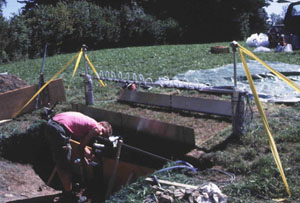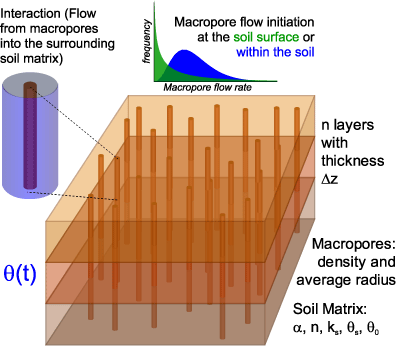| |
|
|
|
|
| |
|
|
|
Introduction |
| |
|
|
|
|
|
Overview |
|
|
|
Water flow in macropores is an important mechanism of infiltration in natural soils
and as such is crucial for the prediction of runoff generation. The major flow
processes controlling macropore flow are the initiation of macropore flow
(water supply into macropores) and the water transfer from the macropores into
the surrounding soil matrix (interaction).
|
| |
|
|
|
|
|
Experi-
ments |
|
|
|
 The water movement during infiltration
and the resulting flow paths were studied with combined sprinkling and dye tracer
experiments under different rainfall intensities and initial soil moisture conditions.
The chosen rainfall intensity mimics a convenctive (60 mm/h) and an advective
(12 mm/h) rainfall event.
The dye tracer was continuously applied with the sprinkling water on
1 m2 plots.
After the sprinkling, horizontal and vertical soil sections were prepared
for surveying
dye patterns, which showed the cumulated flow pathways in the soils. These experiments
were carried out on three hillslope sites covered with grassland, where
earthworms mainly
built the macropore system.
The water movement during infiltration
and the resulting flow paths were studied with combined sprinkling and dye tracer
experiments under different rainfall intensities and initial soil moisture conditions.
The chosen rainfall intensity mimics a convenctive (60 mm/h) and an advective
(12 mm/h) rainfall event.
The dye tracer was continuously applied with the sprinkling water on
1 m2 plots.
After the sprinkling, horizontal and vertical soil sections were prepared
for surveying
dye patterns, which showed the cumulated flow pathways in the soils. These experiments
were carried out on three hillslope sites covered with grassland, where
earthworms mainly
built the macropore system.
|
| |
|
|
|
|
|
Sites |
|
|
|
The following table shows the soil properties of the three experimental sites
in Switzerland.
Site |
Soil Classification |
Geological parent material |
Average values at 30-80 cm depth |
Density
(g cm-3) |
Soil texture |
Macro-porosity
(%) |
Macropore Density(m2) |
Rietholzbach |
Mollic Cambisol |
Conglomerates (molasse) |
1.30 |
clay loam |
0.35 |
228 |
Heitersberg |
Umbric Cambisol |
Moraine |
1.65 |
loam |
0.41 |
357 |
Niederweningen |
Eutric Cambisol |
Sandstone (molasse) |
1.45 |
sandy loam |
0.77 |
623 |
|
| |
|
|
|
|
|
IN3M |
|
|
|
 The process understanding and results from the combined sprinkling and dye tracer
experiments were used to develop the
INfiltration-INitiation-INteraction Model
(IN3M), which describes vertical and horizontal infiltration with a
consistent and stable approach (Green-Ampt), uses physically-based parameters that
can be derived from soil properties, and simulates the interaction for each
macropore. Because of the unique structure of IN3M, dye patterns
can be simulated and the results can be compared with the resulting dye patterns
from the sprinkling experiments.
The process understanding and results from the combined sprinkling and dye tracer
experiments were used to develop the
INfiltration-INitiation-INteraction Model
(IN3M), which describes vertical and horizontal infiltration with a
consistent and stable approach (Green-Ampt), uses physically-based parameters that
can be derived from soil properties, and simulates the interaction for each
macropore. Because of the unique structure of IN3M, dye patterns
can be simulated and the results can be compared with the resulting dye patterns
from the sprinkling experiments.
The simulation of dye patterns illustrates the variety of different processes
and infiltration characteristics in macroporous soils. The simulation can also
help to better understand how water moves in structured soils.
Details to the experiments and IN3M can be found in my
Ph.D. thesis.
|
| |
|
|
|
|

 The water movement during infiltration
and the resulting flow paths were studied with combined sprinkling and dye tracer
experiments under different rainfall intensities and initial soil moisture conditions.
The chosen rainfall intensity mimics a convenctive (60 mm/h) and an advective
(12 mm/h) rainfall event.
The dye tracer was continuously applied with the sprinkling water on
1 m2 plots.
After the sprinkling, horizontal and vertical soil sections were prepared
for surveying
dye patterns, which showed the cumulated flow pathways in the soils. These experiments
were carried out on three hillslope sites covered with grassland, where
earthworms mainly
built the macropore system.
The water movement during infiltration
and the resulting flow paths were studied with combined sprinkling and dye tracer
experiments under different rainfall intensities and initial soil moisture conditions.
The chosen rainfall intensity mimics a convenctive (60 mm/h) and an advective
(12 mm/h) rainfall event.
The dye tracer was continuously applied with the sprinkling water on
1 m2 plots.
After the sprinkling, horizontal and vertical soil sections were prepared
for surveying
dye patterns, which showed the cumulated flow pathways in the soils. These experiments
were carried out on three hillslope sites covered with grassland, where
earthworms mainly
built the macropore system.
 The process understanding and results from the combined sprinkling and dye tracer
experiments were used to develop the
INfiltration-INitiation-INteraction Model
(IN3M), which describes vertical and horizontal infiltration with a
consistent and stable approach (Green-Ampt), uses physically-based parameters that
can be derived from soil properties, and simulates the interaction for each
macropore. Because of the unique structure of IN3M, dye patterns
can be simulated and the results can be compared with the resulting dye patterns
from the sprinkling experiments.
The process understanding and results from the combined sprinkling and dye tracer
experiments were used to develop the
INfiltration-INitiation-INteraction Model
(IN3M), which describes vertical and horizontal infiltration with a
consistent and stable approach (Green-Ampt), uses physically-based parameters that
can be derived from soil properties, and simulates the interaction for each
macropore. Because of the unique structure of IN3M, dye patterns
can be simulated and the results can be compared with the resulting dye patterns
from the sprinkling experiments.